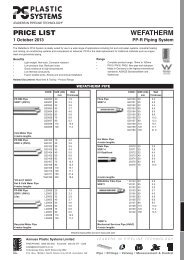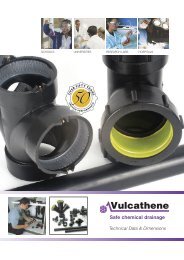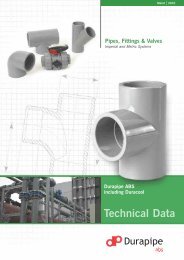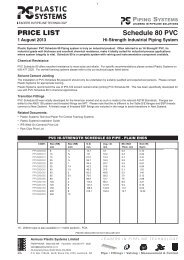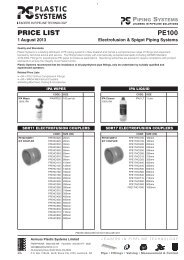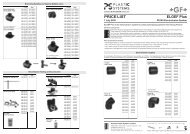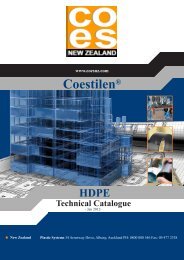Beta (b)-PP from Georg Fischer A synonym for ... - Plastic Systems
Beta (b)-PP from Georg Fischer A synonym for ... - Plastic Systems
Beta (b)-PP from Georg Fischer A synonym for ... - Plastic Systems
You also want an ePaper? Increase the reach of your titles
YUMPU automatically turns print PDFs into web optimized ePapers that Google loves.
Notch sensitivity<br />
To analyse the impact strength, the Charpy impact test<br />
according to DIN EN ISO 179-1 has become an established<br />
method in Europe.<br />
In Fig. 4 the notched impact tests of various <strong>PP</strong> types<br />
are depicted in relation to temperature. These are<br />
minimum values which are achieved in competent<br />
processing in the injection moulding, extrusion as well<br />
as compression moulding.<br />
notch impact resistance in<br />
kJ/m2<br />
18<br />
16<br />
14<br />
12<br />
10<br />
8<br />
6<br />
4<br />
2<br />
0<br />
Minimum values of notched impact test<br />
<strong>Beta</strong>-<strong>PP</strong>-H<br />
<strong>PP</strong>-R<br />
Alpha-<strong>PP</strong>-H<br />
Alpha-<strong>PP</strong>-H un-nucleated<br />
-10 0 10 20<br />
Temperatur in °C<br />
Fig. 4: Minimum values of notch impact strength of<br />
different <strong>PP</strong> types according to DIN EN ISO 179/1eA<br />
These results were determined in a wide-ranging<br />
study. <strong>Beta</strong>-<strong>PP</strong>-H exceeds the DIN EN 1778 (DVS<br />
2205-1) and the DIN EN ISO 15494 norm requirements<br />
over the entire temperature range.<br />
Comprehensive tests on injection moulded test specimens<br />
illustrate the high notch impact resistance of<br />
<strong>Beta</strong>-<strong>PP</strong>-H.<br />
notch impact resistance in kJ/m 2<br />
110<br />
100<br />
90<br />
80<br />
70<br />
60<br />
50<br />
40<br />
30<br />
20<br />
10<br />
0<br />
<strong>Beta</strong>-<strong>PP</strong>-H<br />
Molded Fittings<br />
Alpha-<strong>PP</strong>-H<br />
Molded Fittings<br />
-20 -10 0 10 15 23 40 50<br />
Temperature in °C<br />
Fig. 5: Notch impact resistance according to DIN EN<br />
ISO 179/1eA of different <strong>PP</strong>-H types on moulded fittings<br />
In comparison to Alpha-<strong>PP</strong>-H or <strong>PP</strong>-R, <strong>Beta</strong>-<strong>PP</strong>-H<br />
has the highest notched impact resistance. This<br />
results in a very high level of safety against external<br />
impact stress, especially at low temperatures,<br />
which could occur during transport, installation or<br />
even during operation (e.g. water hammer, vibration)<br />
of a piping system.<br />
Welding quality of <strong>Beta</strong>-<strong>PP</strong>-H piping systems<br />
The <strong>Georg</strong> <strong>Fischer</strong> concept of system solutions, which<br />
also applies to the <strong>Beta</strong>-<strong>PP</strong>-H line, presupposes that<br />
all the individual components are compatible with one<br />
another. This is particularly true in the case of welding<br />
(butt fusion with heating element or non-contact infrared<br />
(IR-Plus)). The material used <strong>for</strong> pipes and fittings<br />
is subjected to one and the same specification that<br />
has been adapted to the individual requirements of<br />
<strong>Georg</strong> <strong>Fischer</strong>.<br />
The <strong>Beta</strong>-<strong>PP</strong>-H material used by <strong>Georg</strong> <strong>Fischer</strong> shows<br />
a melt flow behaviour, which complies with all the<br />
requirements of the relevant standard (DVS-2207-11)<br />
regarding <strong>PP</strong> weldability. <strong>Georg</strong> <strong>Fischer</strong> <strong>Beta</strong>-<strong>PP</strong>-H<br />
pipes and fittings can there<strong>for</strong>e be welded without any<br />
problems with other <strong>PP</strong> pipes in accordance with the<br />
DVS, or are compatible as long as the latter also meet<br />
the material specifications of the DVS 2207-11.<br />
It has to be the objective of every jointing method of<br />
system components to avoid discontinuities in properties<br />
or weak spots in the joint. Concerning <strong>Beta</strong>-<strong>PP</strong>-H<br />
this means that the welding itself should reveal the<br />
same characteristics as the pipes and fittings. To<br />
examine this aspect in more detail, pipes were joined<br />
with fittings (T-piece 110x10 mm) by butt fusion according<br />
to DVS guidelines using a heating element as<br />
well as with the IR-Plus ® technology; the material<br />
structure was analysed in the fusion zone and compared<br />
to the data measured on the semi-finished<br />
product. Fig. 6 shows the results of the structure<br />
analysis (WAXS) on the welded <strong>Beta</strong>-<strong>PP</strong>-H pipe system.<br />
5



